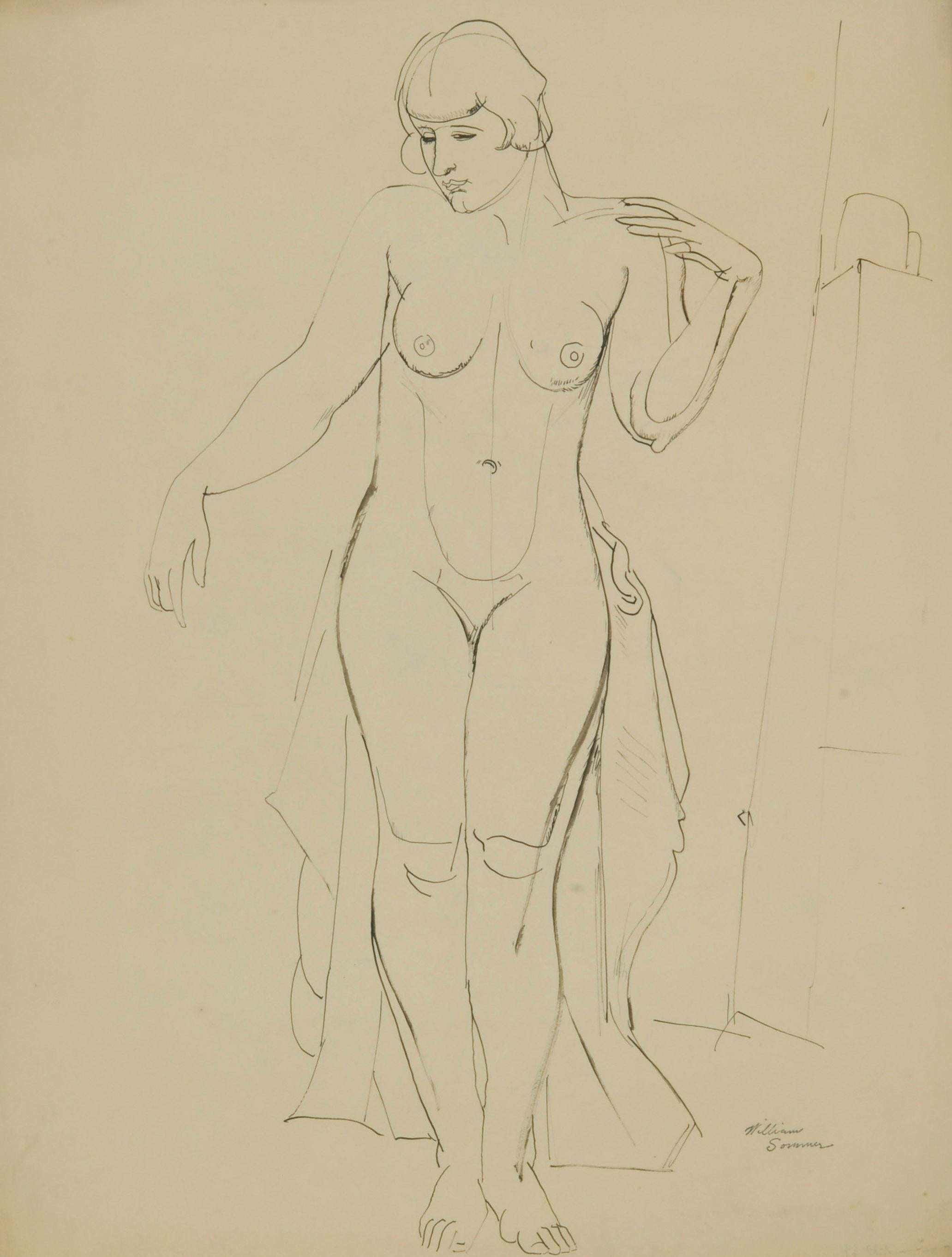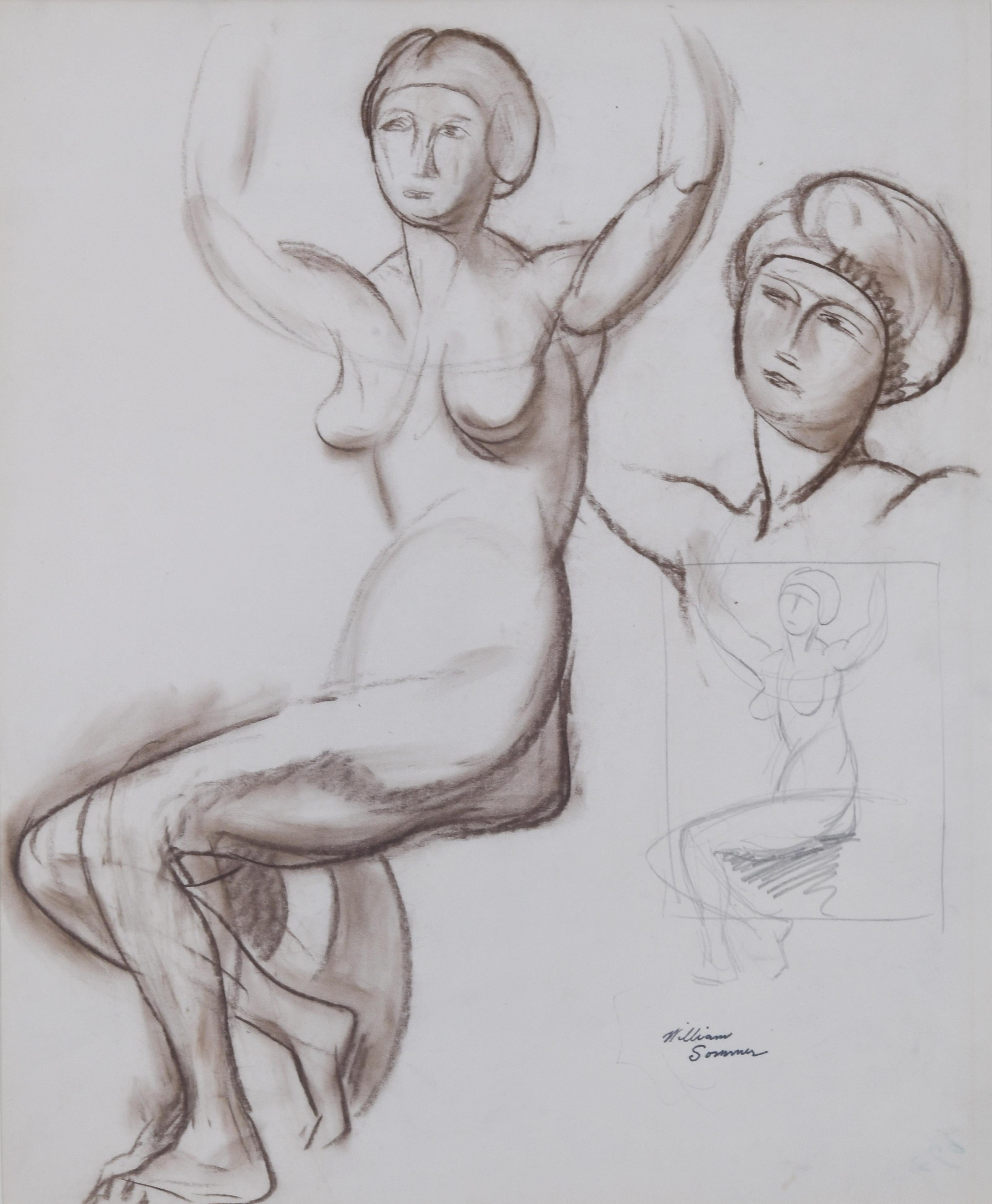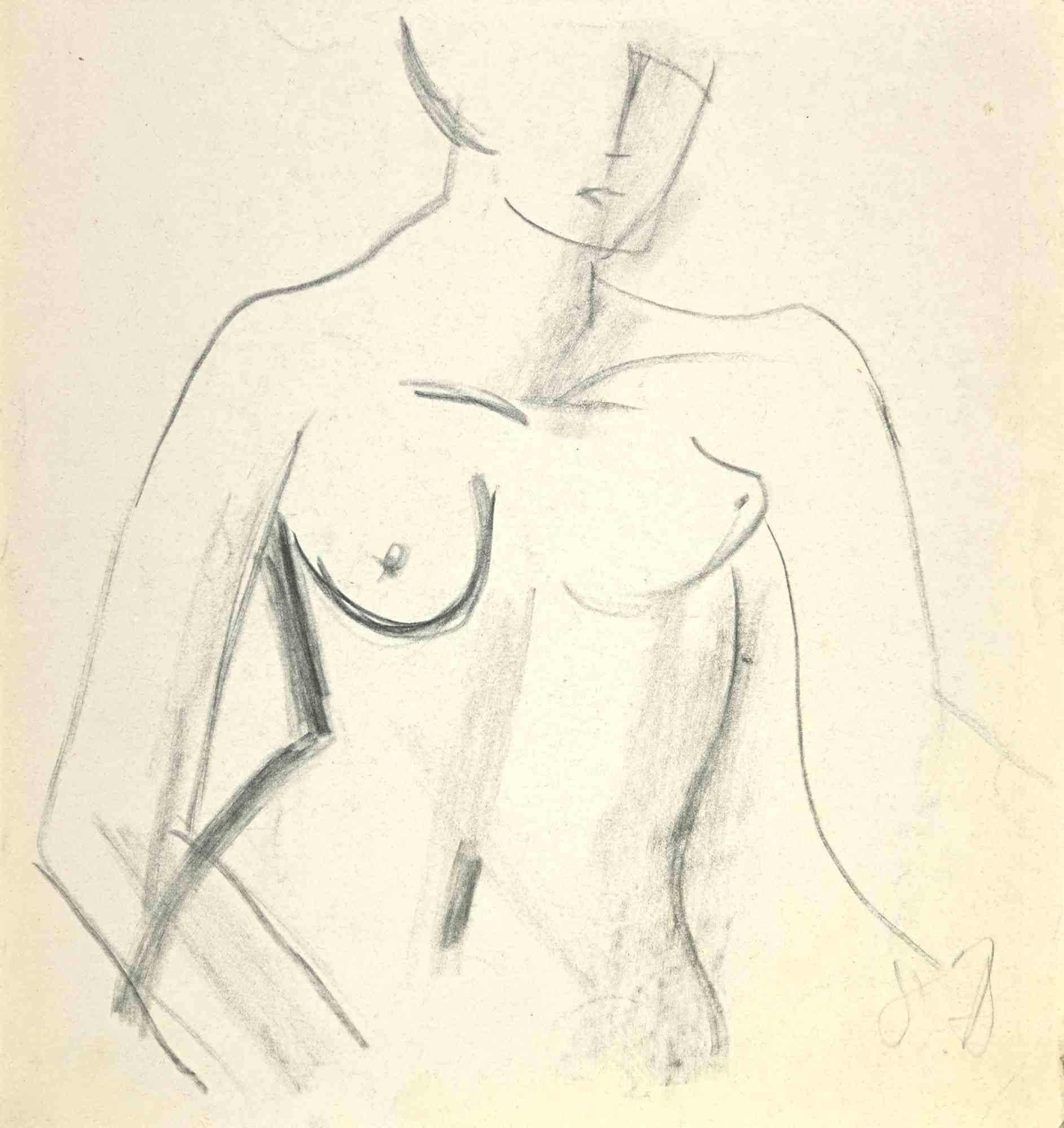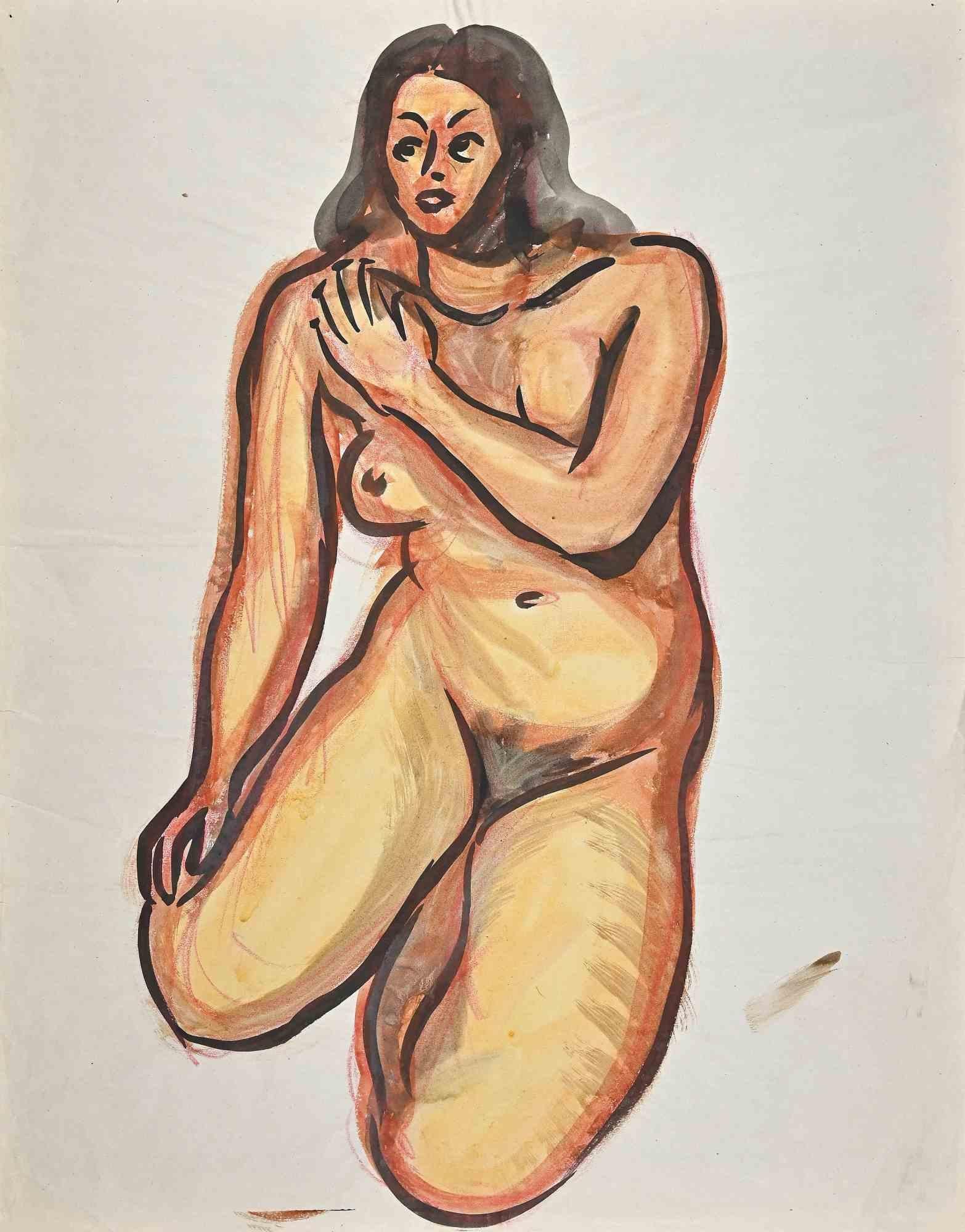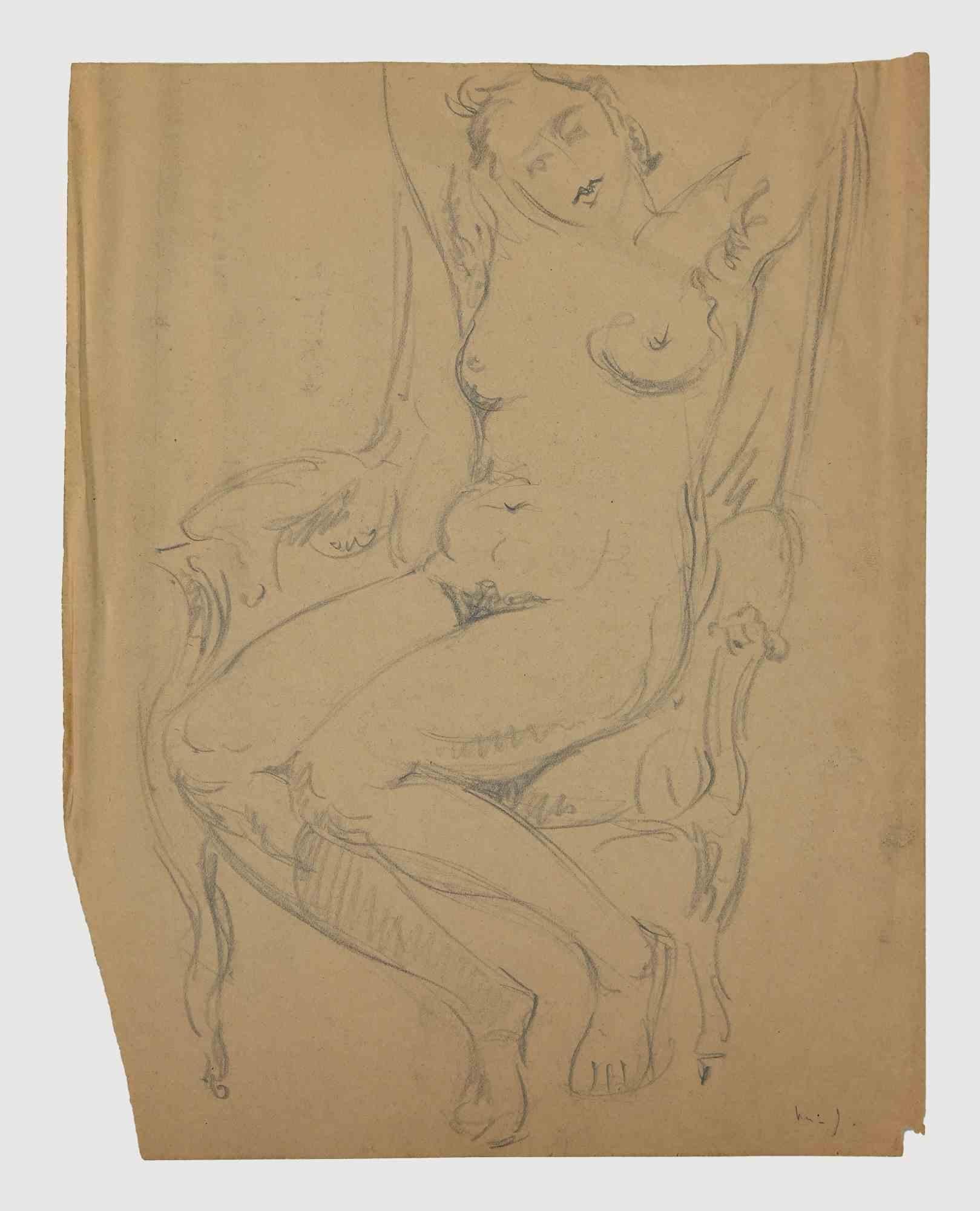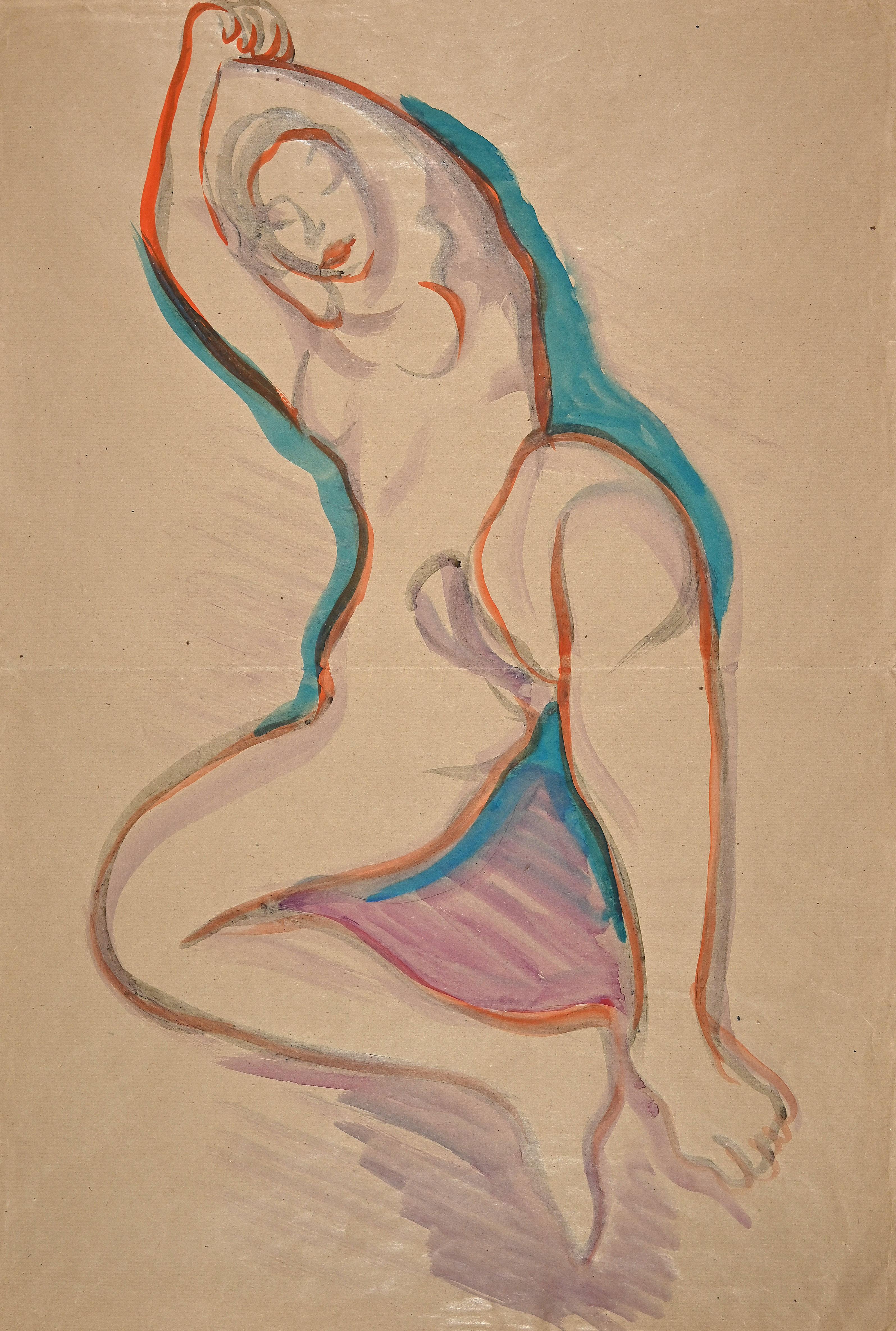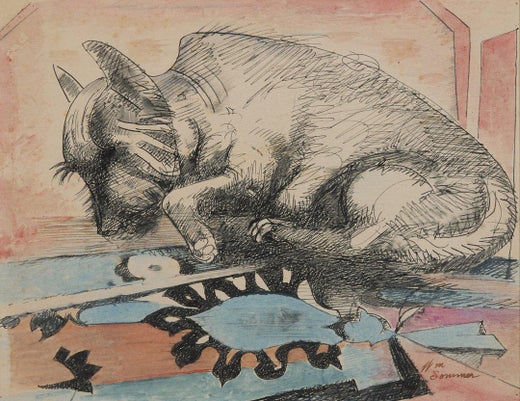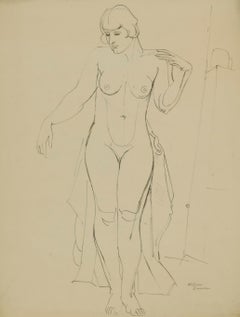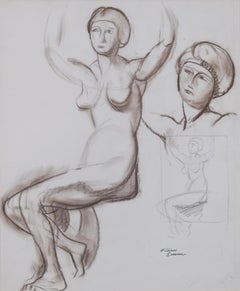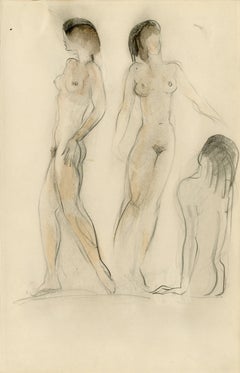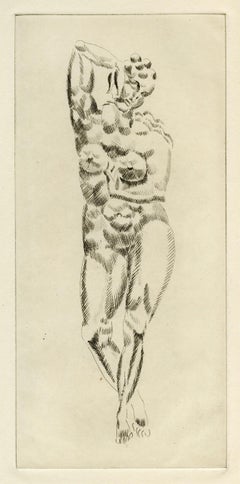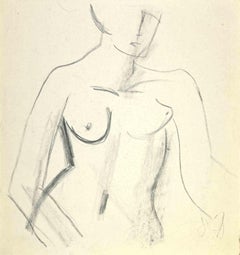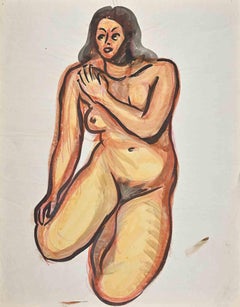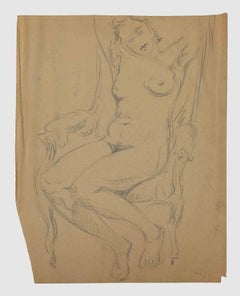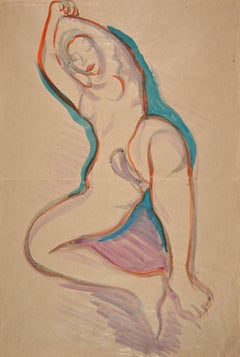Items Similar to Nude, arms raised
Want more images or videos?
Request additional images or videos from the seller
1 of 12
William SommerNude, arms raisedc. 1925
c. 1925
$3,500
£2,675.94
€3,082.14
CA$4,904.57
A$5,475.49
CHF 2,869.08
MX$67,025.43
NOK 36,437.30
SEK 34,355.75
DKK 23,002.31
Shipping
Retrieving quote...The 1stDibs Promise:
Authenticity Guarantee,
Money-Back Guarantee,
24-Hour Cancellation
About the Item
Nude
Matchstick and ink drawing heightened with conte crayon
c. 1925
Signed with the Estate Stamp "B"
Provenance: Joseph A. Erdelac (1914 -2005), Cleveland
Acquired from Edward Sommer, son of the artist
Note: Sommer used this European technique of dipping a softened matchstick in ink for the greater flexibility and control it gave him.
Illustrated: Henry Adams, Out of the Kokoon, 2011, page 40, Figure 27 (see photo)
Hunter Ingalls, The Several Dimensions of William Sommer, Columbia Univ., 1970, related to
page 276, figure 65
Biography: William Sommer (1867–1949) was an American Modernist painter.
William Sommer was born in Detroit, Michigan in 1867. He was largely self-taught, but received instruction early on from artist and commercial lithographer Julius Melchers. He apprenticed with the Detroit Calvert Lithograph Company for seven years but in 1890 he traveled to Europe where he trained with Professors Johann Herterich, Ludwig Schmid, and Adolph Menzel. In 1907 he accepted a position with the Otis Lithograph Company of Cleveland, Ohio and in 1911 he co-founded the Kokoon Arts Club to promote modern art in Cleveland. In 1914 he relocated to Brandywine, Ohio. He worked on several large-scale murals for the Federal Art Project, including Rural Homestead in the Geneva, Ohio post office.
Biographical Highlights[edit]
• 1878-1883: Studies with Julius Melchers
• 1881-1888: Works as lithographic apprentice in Detroit for Calvert Lithograph Co.
• 1888-1907: Works as lithographic journeyman in Boston, England, Munich, and NYC; Sommer studied fine art in Munich for a year in 1890, then returned to New York City and married. Sommer continued to work as lithographer and privately concentrated on his own art.
• 1892: Sommer joins NYC's bohemian artists' group known as the Kit Kat Klub.
• 1907: Sommer moves his wife and children to Cleveland where he worked for Otis Lithograph Co.; the Sommer family ultimately settled in Brandywine, Ohio (today Northfield). Sommer remained there, working in Cleveland and painting in watercolors and oils at home and on outdoor junkets.
• 1912- : Sommer co-founds Cleveland's bohemian artists' group known as the Kokoon Arts Club; exhibits in the 1913 Taylor Show, Cleveland's response to the Armory Show in NYC; frequents the Laukhuff Bookstore with other members of the Kokoon Club; this club was known for its evening activities of "painting, talking, reading and--not infrequently--drinking. . . .the Kokoon Club would still be honored today as the home-away-from-home of William Sommer."[1]
• 1929: Sommer loses his job as a lithographer to the new offset printing process
• 1933: Sommer exhibits at the Whitney Biennial and the Museum of Modern Art, both in NYC; paints mural for the Cleveland Public Hall as part of the Public Works of Art Project
• 1934: Sommer paints a mural for the Cleveland Public Library
• 1937-1949: Sommer receives numerous exhibitions and one-artist shows in NYC, Cleveland, Cincinnati, Youngstown, Oberlin, and Akron[citation needed]
Artist William Sommer spent most of his life in Summit County near Brandywine Falls. Sommer was an acknowledged leader of the "Cleveland School," a group of Cleveland-based artists who were active from the teens through the mid-1940s. These artists formed the core of an art community whose size and activity paralleled the growth and energy of Cleveland during that period. Sommer painted from the turn of the 20th century into the 1940s, absorbing the ideas of the Cubists and other adventurous artists of that time and integrating these concepts and techniques into his own work. His subjects were thoroughly rooted in the American midwest, however; favorite subjects included young children and farm scenes.
He continued to paint until his death in 1949. Hart Crane dedicated his 1927 poem Sunday Morning Apples to Sommer.
Courtesy of Wikipedia
- Creator:William Sommer (1867-1949, American)
- Creation Year:c. 1925
- Dimensions:Height: 22.125 in (56.2 cm)Width: 16.625 in (42.23 cm)
- Medium:
- Movement & Style:
- Period:
- Condition:Original Condition, slight imperfections.
- Gallery Location:Fairlawn, OH
- Reference Number:Seller: FA48951stDibs: LU14014264272
William Sommer
William Sommer is seen as a key person in bringing European modernism to Northeast Ohio. He was born in Detroit, Michigan, and in his youth apprenticed for seven years to a lithographer. He briefly studied at an art academy in Germany and then worked as a lithographer in New York before moving to Cleveland, where he was awarded a major contract with the Otis Lithography Company. There he became friends with sculptor and painter William Zorach, and the two, determined to be fine artists, began painting together on weekends. They also became intrigued by avant-garde movements, especially after Zorach's trip to Paris in 1910. In 1911, Sommer co-founded a group in Cleveland called the Kokoon Club, a mixed group of commercial artists and radical modernists who sought the freedom to pursue their independent tendencies. They converted a tailor's shop into a studio and held exhibitions and lectures and organized an annual masked ball that became the focus of Cleveland's bohemian life. In 1913, he and his colleagues began painting at Brandywine, about 30 miles south of Cleveland and made a school house into a studio. They devoted increasing time to watercolor painting because they could work spontaneously and it would dry quickly. Rejecting the conventional ideas of beauty, they strove for the expression of emotion and spontaneity and fantasy. One of Sommer's most successful students was Charles Burchfield. As he was perfecting his mature style, he had financial difficulties because he made his living from commercial lithography, which was becoming obsolete, and the Depression was hitting the nation causing him to lose his job. He became a WPA artist, doing murals in northeastern Ohio. After his death at age 82, he was largely forgotten until 1980 when Hilton Kramer, a "New York Times" critic, praised his work. In May to July, 1994, the Ohio Arts Council held a retrospective of his work at the Riffe Gallery in Columbus. His work is found in many public collections including the National Museum of American Art, The Metropolitan Museum of Art, and the Whitney Museum of American Art.
About the Seller
5.0
Recognized Seller
These prestigious sellers are industry leaders and represent the highest echelon for item quality and design.
Gold Seller
Premium sellers maintaining a 4.3+ rating and 24-hour response times
Established in 1978
1stDibs seller since 2013
799 sales on 1stDibs
Typical response time: <1 hour
Associations
International Fine Print Dealers Association
- ShippingRetrieving quote...Shipping from: Fairlawn , OH
- Return Policy
Authenticity Guarantee
In the unlikely event there’s an issue with an item’s authenticity, contact us within 1 year for a full refund. DetailsMoney-Back Guarantee
If your item is not as described, is damaged in transit, or does not arrive, contact us within 7 days for a full refund. Details24-Hour Cancellation
You have a 24-hour grace period in which to reconsider your purchase, with no questions asked.Vetted Professional Sellers
Our world-class sellers must adhere to strict standards for service and quality, maintaining the integrity of our listings.Price-Match Guarantee
If you find that a seller listed the same item for a lower price elsewhere, we’ll match it.Trusted Global Delivery
Our best-in-class carrier network provides specialized shipping options worldwide, including custom delivery.More From This Seller
View AllStanding Female Nude
By William Sommer
Located in Fairlawn, OH
Standing Female Nude
Match stick and ink drawing, c. 1925
Signed with the estate stamp B
Sheet size: 21 x 16 inches
Created at the Kakoon Arts Klu...
Category
1920s American Modern Nude Drawings and Watercolors
Materials
Ink
Female Nude Study
By William Sommer
Located in Fairlawn, OH
Female Nude Study
Graphite and crayon on wove paper, c. 1928
Signed with the Estate stamp "B" (see photo)
Provenance: Estate of the Artist
Edward Sommer (his so...
Category
1920s American Modern Nude Drawings and Watercolors
Materials
Crayon
Untitled (Two Standing Nudes, one seated nude)
By Boris Lovet-Lorski
Located in Fairlawn, OH
Untitled (Two Standing Nudes, one seated nude)
Graphite on wove paper, heightened with color, c. 1930
Unsigned
From a sketchbook created while the artist was working in Paris
Conditi...
Category
1930s Art Deco Nude Drawings and Watercolors
Materials
Graphite
Female Nude - Standing Female Nude (Havard)
By Elie Nadelman
Located in Fairlawn, OH
Female Nude - Standing Female Nude (Havard)
Drypoint, 1920
Unsigned, as issued in the portfolio
No signed impression are known to exist
From: The Drypoint...
Category
1920s American Modern Nude Prints
Materials
Drypoint
Standing Female Nude
By Aaron Bohrod
Located in Fairlawn, OH
Standing Female Nude
Ink on paper
Signed by the artist with his initials lower left "AB"
Related to numerous drawings of the same model illustrated in: Elliott and Wooden, Aaron Bohr...
Category
1950s American Realist Nude Drawings and Watercolors
Materials
Ink
Untitled (seated female nude)
By Henry Keller
Located in Fairlawn, OH
Seated Femake Nude
Graphite and chalk on tan paper, c. 1920
Signed "Keller" and signed again with the artist's initials in a cypher
A finished life drawing most probably exhibited at...
Category
1920s American Modern Nude Drawings and Watercolors
Materials
Graphite
You May Also Like
The Nude - Drawing by L. B. Saint-André - Mid 20th Century
By Louis Berthomme Saint-Andre
Located in Roma, IT
The Nude is a drawing, realized in Mid 20th Century, by the French post-impressionist painter and illustrator Louis André Berthommé Saint-André (1905-1977).
Black and white penc...
Category
Mid-20th Century Contemporary Figurative Drawings and Watercolors
Materials
Paper, Pencil
Nude - Drawing by Jean Delpech - Mid 20th century
By Jean Delpech
Located in Roma, IT
Nude is a drawing in watercolor realized in the Mid-20th Century by Jean Delpech (1916-1988).
Good conditions with minor folding.
The artwork is realiz...
Category
Mid-20th Century Modern Figurative Drawings and Watercolors
Materials
Paper, Watercolor
$378 Sale Price
20% Off
Nude - Original Drawing - Early 20th Century
Located in Roma, IT
Nude is an original drawing in pencil realized by an anonymous artist in the early 20th Century.
Good conditions except for some foxings.
The artwork is depicted through strong str...
Category
20th Century Modern Figurative Drawings and Watercolors
Materials
Pencil
Nude - Watercolor by Jean Delpech - Mid 20th century
By Jean Delpech
Located in Roma, IT
Nude is an original drawing in watercolor, realized in the Mid-20th Century by Jean Delpech (1916-1988).
Good conditions.
Jean-Raymond Delpech (1988-1916) is a French painter, eng...
Category
Mid-20th Century Modern Figurative Drawings and Watercolors
Materials
Watercolor
$359 Sale Price
20% Off
Nude Woman - Drawing by Jean Chapin- 1950s
By Jean Chapin
Located in Roma, IT
Nude Woman is a pencil and charcoal drawing realized by Jean Chapin in the 1950s.
Signature stamp on the yellowed paper.
Good condition, except for slight folding.
Category
1950s Modern Figurative Drawings and Watercolors
Materials
Charcoal, Pencil
A Very Finely Drawn 1930s Modern Figure Study of a Standing Female Nude Model
By Harold Haydon
Located in Chicago, IL
A Very Finely Drawn, 1930s Modern Figure Study of a Standing Female Nude Model (Back) by Notable Chicago Modern Artist, Harold Haydon (Am. 1909-1994). An early composite charcoal d...
Category
1930s American Modern Figurative Drawings and Watercolors
Materials
Charcoal, Paper
